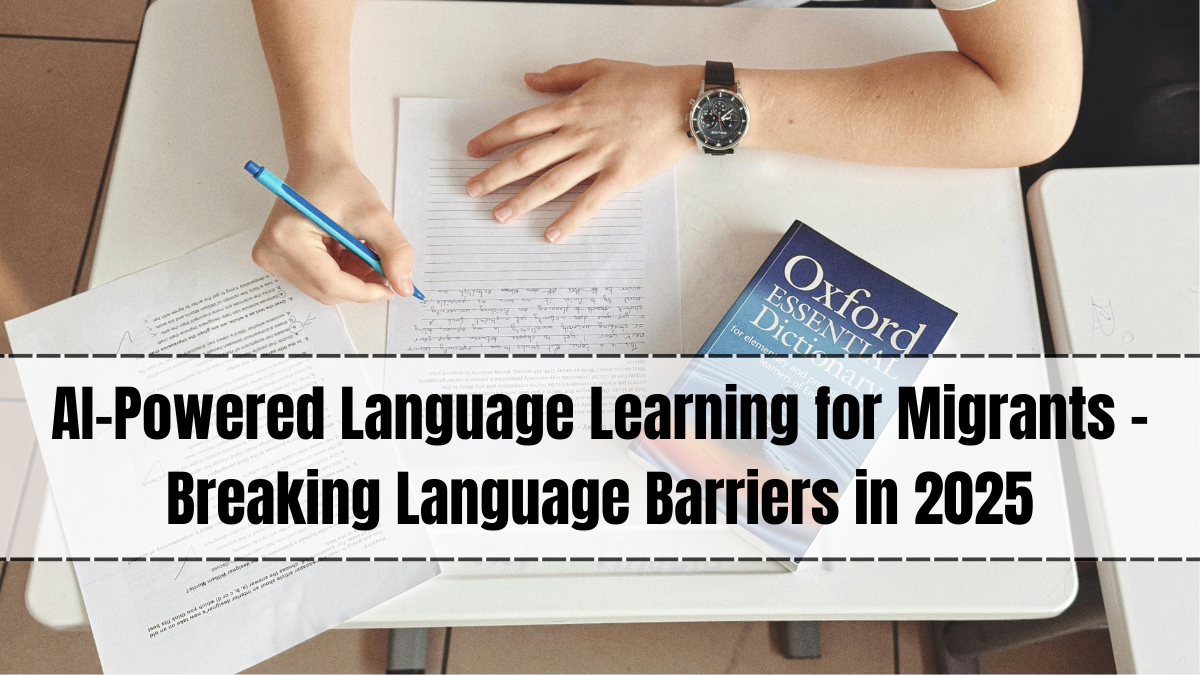In 2025, migration is at an all-time high, with millions of people moving across borders for work, education, and better living conditions. While these opportunities are transformative, migrants often face one critical challenge upon arrival in a new country—language barriers. The inability to communicate fluently in the local language can hinder job prospects, access to public services, and even day-to-day interactions. Recognizing this, technology companies, governments, and education providers are turning to artificial intelligence to make language learning faster, more effective, and more accessible for migrants worldwide.
AI-powered language learning tools are not just digital dictionaries or static phrasebooks—they are interactive, adaptive systems that personalize learning for each user. These platforms use speech recognition, natural language processing (NLP), and machine learning to understand the learner’s strengths, weaknesses, and preferred pace. They then create customized lessons that focus on practical communication skills needed for real-life situations. Whether it’s learning industry-specific vocabulary for a new job, practicing conversational skills for social integration, or understanding local slang, AI is making the process smarter and more engaging.
For migrants, time is often the biggest barrier to language acquisition. They may need to start work soon after arrival, leaving little opportunity for formal classroom courses. AI-driven platforms provide flexibility, allowing learners to study anytime, anywhere, using smartphones, tablets, or computers. This “learn on the go” approach fits seamlessly into the busy lives of migrants, making language learning more accessible than ever before.

Why AI is a Game-Changer for Migrants
Traditional language learning methods can be slow and generalized, often failing to address the specific needs of individual learners. Migrants require targeted learning that prioritizes the vocabulary, grammar, and cultural nuances they will encounter daily. AI-powered systems can:
-
Analyze the learner’s speech for pronunciation accuracy and provide instant feedback
-
Adapt lesson difficulty based on the user’s progress
-
Include real-world scenarios relevant to the learner’s profession or living environment
-
Offer multilingual support to bridge the gap between the learner’s native language and the target language
-
Track progress with detailed analytics, motivating learners to stay consistent
By providing an immersive and personalized experience, AI platforms help migrants achieve conversational fluency more quickly, boosting confidence and independence.
Features of AI-Powered Language Learning Platforms
The latest AI language learning tools offer a range of advanced features that go beyond traditional teaching methods:
-
Voice recognition to evaluate pronunciation and suggest improvements
-
Context-based translations to ensure words are understood in real-life usage
-
Gamification elements such as points, badges, and leaderboards to keep learners engaged
-
AI chatbots for simulated conversations that mimic real interactions
-
Augmented reality (AR) integration for visual learning in immersive settings
-
Offline learning modes for migrants in areas with limited internet connectivity
These features make learning more interactive and engaging, encouraging daily practice—a key factor in achieving fluency.
Benefits for Migrants
The impact of AI-powered language learning on migrants’ lives is significant. Firstly, it accelerates integration into their new community by enabling them to communicate effectively with neighbors, colleagues, and service providers. This can reduce feelings of isolation and improve mental well-being. Secondly, it enhances employability, as many employers prioritize candidates who can speak the local language fluently. Finally, it empowers migrants to access healthcare, education, legal services, and government programs without relying heavily on translators.
For example, a construction worker migrating from India to Germany can use an AI platform to quickly learn safety instructions, technical terms, and common workplace phrases in German. Similarly, a nurse moving to Canada can focus on patient communication skills and medical vocabulary in English or French.
Benefits for Host Countries and Employers
AI-driven language training is also advantageous for host countries and employers. When migrants can communicate effectively, workplace productivity increases, customer service improves, and integration into society becomes smoother. It also reduces the burden on translation services in hospitals, schools, and public offices, saving costs for governments and organizations.
Employers can partner with AI language learning providers to offer tailored programs for migrant employees, ensuring they acquire the specific language skills needed for their roles. This approach not only supports professional development but also builds loyalty and reduces turnover rates.
Real-World Examples and Success Stories
Several countries are already implementing AI-powered language learning programs for migrants. In Australia, a government-backed initiative provides free access to AI-driven English learning apps for new immigrants, helping them adapt to life and work quickly. In Japan, employers in the hospitality sector use AI tools to train foreign staff in Japanese, enabling smoother customer interactions.
One inspiring story comes from a group of Syrian refugees in Sweden who used AI platforms to learn Swedish within months, enabling them to secure jobs in healthcare, education, and small businesses. The personalized learning paths and real-time feedback helped them progress much faster than traditional classroom methods alone.
Challenges and the Path Forward
While the technology is promising, challenges remain. Digital literacy is a barrier for some migrants, especially those with limited experience using smartphones or computers. Access to reliable internet can also be an issue, though offline features are helping address this. Additionally, there is a need for culturally sensitive content that respects and incorporates the learner’s background while teaching the new language.
Looking ahead, the future of AI-powered language learning will likely include even more immersive features, such as virtual reality environments where learners can practice in simulated real-world scenarios. Partnerships between governments, NGOs, and tech companies will be key in expanding access and ensuring affordability for all migrants who need these tools.
FAQs
What is AI-powered language learning for migrants?
It is the use of artificial intelligence to create personalized, interactive, and efficient language learning experiences tailored to the needs of migrants.
How does AI improve the learning process?
AI adapts lessons to each learner’s pace, provides instant feedback, and focuses on relevant real-world vocabulary.
Can these tools work without internet access?
Yes, many platforms offer offline learning options for areas with limited connectivity.
Are these tools free for migrants?
Some are free through government or NGO programs, while others may require a subscription.
Which languages are most commonly taught through these programs?
English, French, German, Japanese, and Spanish are among the most popular, depending on the destination country.
Click here to know more.
